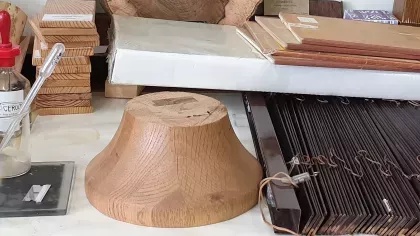World Forest ID
Building the world’s largest geo-referenced, open source, forest sample collection to tackle fraud, illegal logging and deforestation

The World Forest ID consortium is building the world’s largest geo-referenced, open source, forest sample collection.
With this collection a range of scientific methods are being used to confirm or challenge claims about the species and provenance of forest products, to tackle fraud, illegal logging and deforestation.
The integrity of sample libraries is critical to using science to disrupt illicit supply chains and promote due diligence.
World Forest ID has established protocols and tools for sample collection which ensure that all forest source material lodged in the collection will be subject to the highest levels of scrutiny.
For example, the World Forest ID app, collaboration with the University of Tennessee, USA) allows to track the sample from field to collection and subsequent analysis by using unique barcode identifiers.
Once material is in the collection, the World Forest ID partnership is developing a database of chemical (DART-TOFMS), isotopic, and anatomical reference material against which certified labs can assess the species and origin claims of traded timber.
Through World Forest ID, new timber identification and tracking methods are also assessed and determined whether they could have a global potential. Currently, the consortium uses the following techniques:
- Stable isotope ratio analysis: This technique is used to recognize geographical location. It works by measuring the natural variation of the isotopes of carbon, nitrogen, sulphur, hydrogen and oxygen.
- DART-TOFMS (Direct Analysis in Real Time – Time of Flight Mass Spectrometry): This technique is used to accurately identify small slivers of wood to species level. With adequate reference materials this technique can also identify general geographic origin.
- Wood anatomy: This technique can be used to identify wood samples, usually to genus level, and if provenance information can be trusted, sometimes to species level. Currently it requires the expertise of a wood anatomist, but image analysis, artificial intelligence and machine learning techniques are being developed.
- The role of the Royal Botanic Gardens Kew is as a central hub for the World Forest ID collection. Samples are shipped from all over the world to Kew, where they go through the quarantine process and they get accessioned and curated. At Kew, the samples also undergo wood anatomical analysis and images are taken to strengthen the Xylotron database. Subsamples are taken and shipped out to the corresponding labs for DART-TOFMS and stable isotope analysis (see Wider Consortium).
Kew Programme Leader
Kew Team
Peter Gasson
Victor Deklerck
Isabella A. Miles-Bunch
Sara Redstone
Josie Stuart
Joanna Bates
Department for Environment, Food & Rural Affairs (Defra)
- Royal Botanic Gardens, Kew
- Agroisolab
- US Forest Service International Programs
- World Resources Institute
- FSC
Gasson, P.E., Lancaster, C.A., Young, R., Redstone, S., Miles-Bunch, I.A., Rees, G.O., Guillery, P., Parker-Forney, M. & Lebow, E.T. (2020)
WorldForestID: Addressing the need for standardized wood reference collections to support authentication analysis technologies; a way forward for checking the origin and identity of traded timber.
Plants, People, Planet 3: 130-141.
Watkinson, C.J., Rees, G.O., Boner, M.M. & Erven, C. (2020)
Establishing a basis for evaluating geographic origin claims of timber from the Solomon Islands using stable isotope ratio analysis.
Report
Rees, G.O., Watkinson, C.J., Boner, M.M., Hofem, S. & Michely, L. (2020)
Today’s forests for tomorrow’s world: Stable Isotope Ratio Analysis of timber to protect two forest concessions in Gabon.
Report
The World Forest ID project has been featured on:
BBC 'Is your wood from a legal source?'
CNN 'How a library of tree DNA could protect the world's forests'
The Guardian 'Kew’s tree library leads hi-tech war on illegal logging'
NY Times 'Can a DNA Database Save the Trees? These Scientists Hope So'
PBS 'Scientists Build Lumber Library to Identify Poached Wood'
Nature 'Tree sleuths are using DNA tests and machine vision to crack timber crimes'
ScienceNews 'Can forensics help keep endangered rosewood off the black market?'
